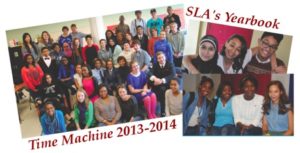Juliana Long
Staff Writer

For the last several years, Yearbook has been offered as a half-credit elective to students interested in helping with the production of the annual project.
The class is running this year with 21 students. However, to the dismay of the seniors who expected to return to the class, only one was rostered into the yearbook elective. Senior Kimberly Gucciardi-Kreigh, who has spent 2 of her 3 and a half years at SLA on SLA’s yearbook committee, reported that she and her friends were very surprised and disappointed at the change.
“We used to listen to music and dance while making pages! It was so much fun to laugh at funny pictures of our friends,” she stated about her experience in the yearbook elective.
The seniors’ disappointment wasn’t the only unfortunate result of this. According to History Teacher and Yearbook Advisor Pearl Jonas, the seniors in the yearbook elective would typically curate all of the senior pages. This duty is now the responsibility of sophomores and juniors in the elective, which adds more tasks onto their plate and takes up time that could be spent perfecting other aspects of the yearbook.
Jonas explained why the invested yearbook committee seniors didn’t get rostered into the class: there were complications in rostering seniors into a class that they had previously taken in prior years.
This does not mean the end of senior involvement in the yearbook as we know it. Once the rostering problem was discovered, Ms. Jonas curated a Senior Committee, whom she described as “A group of seniors, mostly who did yearbook last year, who wanted to get more of a senior voice in the yearbook.”
Gucciardi-Kreigh elected to be on the committee, which meets whenever Ms. Jonas contacts the members (typically once a month). “So far, it’s been us contributing ideas. We had to brainstorm where to put the senior quotes and how we wanted the pages to be formatted,” she says.
She claims that the Senior committee is less involved than the elective, saying “Last year in the elective it was more like we made the pages, but this year it’s more about us coming up with ideas.”
Former yearbook committee member and senior Lauren Nicolella says that she hasn’t heard much about the senior committee at all.
“There hasn’t been a lot of involvement, I guess. I haven’t seen or heard a lot besides some random times in the halls to collect photos for the essence of SLA or something.”
Regardless of the success of the senior committee, Ms. Jonas says that she has spoken with Sunil Reddy, Roster Chair at SLA, about the complication that prevented seniors from getting rostered into the yearbook elective. It’s safe to say that next year, the incoming seniors will continue their involvement in yearbook through the elective if they so prefer.


